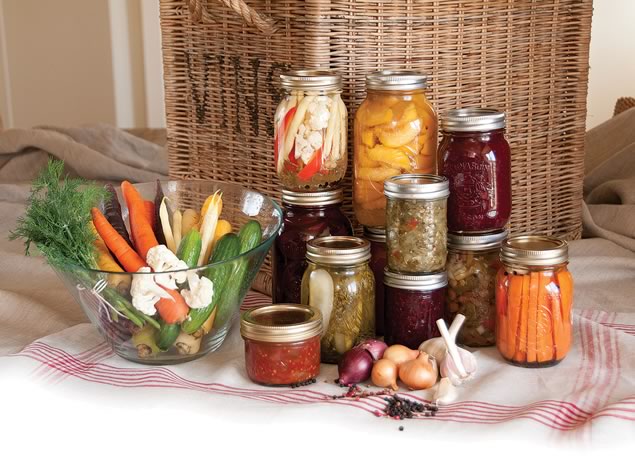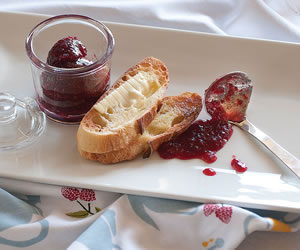The Practical Art of Preserving
Learn to make canning part of your food strategy and keep the whole thing manageable, by year-round canning.

Cathy Hansen is a Canadian Red Seal Chef, owner of Bernway Farm Organically Grown Produce, and Philosopher’s Kitchen in Ospringe, Ontario.
I grew up in a neighbourhood in east Oakville, a place with lots of kids and roomy backyards. One of my fondest memories was watching my parents’ “postage stamp” garden being turned and planted, and ultimately producing dark red beets and juicy raspberries.
These crops stuck with me because they were the two things my mother preserved in sparkling jars to be savoured on special occasions. I had no idea how this happened, probably in the wee hours when her five daughters were tucked away. But when it came time for me to exercise my own green thumb, one of the first things I did was teach myself to create those same wonderful preserves.
That was 25 years ago. Today, my husband and I operate an organic market garden and produce a variety of canned products under the name Philosophers’ Kitchen. Mum’s pickled beets are still a favourite.
Nostalgic ideas about home canning are common. Something from another time: complicated, lovely to look at, but old-fashioned, outdated and too much work. I beg to differ. If you can cook, you can can. Boiling-water-bath canning is done by immersing jars of food in boiling water. The basic steps are the same and can be applied to all your canning recipes.
Around here, we refer to canning as part of our “food strategy.” Local organically grown food is our priority, and preserving food in jars helps us to achieve a level of resourcefulness, thrift and pride that homemakers of all generations can relate to. You will be producing things you can’t buy anywhere else, often elevating humble ingredients to creative new culinary heights.
To keep the whole thing manageable, we encourage year-round canning: peaches, pickles and tomatoes in the summer; applesauce, apple butter, beets, chutneys, jams, jellies and sauces in the winter. (Jams made from frozen berries are a wonderful mid-winter project.) Spring finds us sorting out the cold storage and pickling what will not keep any longer. There is no excuse for waste when pickle brine is so easy to make.
I also think of canning as décor. Find a place to display some of your “food art.” It will spark conversation and you will find more canning friends along the way. Canning is a wonderful community event, well suited to collective cooking. But be careful how many secrets you give away. At the end of the learning curve there may be a red ribbon at the local fair for your best jar of this practical art.
Canning Instructions
Follow Cathy’s step-by-step canning instructions in the Dilly Pickle recipe.
Canning Tips
- Canning is an all-season activity. Plan to can local organic produce in season, but save easily stored produce for the fall and winter.
- Vinegar must be at least 5 per cent acetic acid for food safety.
- Wear rubber-lined dishwashing gloves to protect your hands from steam and provide a better grip than oven mitts.
- A teaspoon of vinegar in the canner will prevent a hard-water film on the jars.
- When preparing jars and lids, prepare a few extra in case your yield is greater than you expect.
- Processing time is always measured from the time the water returns to the boil.
- When pickling whole cucumbers, take a thin slice off the blossom end to help keep the pickles crisp.
- To peel large amounts of garlic, separate the cloves and blanch them in boiling water for 60 seconds, then refresh in cold water. Drain immediately and peel. This also works for small onions.
- The sugar in jams and jellies is required for a good “set.” Sugar in pickles, chutneys and salsa is to taste. Sugar in canned fruit is to maintain a firm texture.
- Rhubarb, berries, cherries and currants can easily be frozen and made into jams and spreads when you have more time.
- Slightly underripe fruit contains the most pectin.
- Experiment with different types of vinegar or add spices (peppercorns, hot chilies, bay leaves, mustard seeds) to create your own special pickles.
- Safe food handling training available online at www.ingoodhands.ca
- Find many useful tips and reliable information online at National Centre for Home Food Preservation
Related Recipes

Dilly Pickles
May 16, 2012 | | FoodWhen pickling whole cucumbers, take a thin slice off the blossom end to help keep the pickles crisp.

Not-Too-Sweet Raspberry Jam
May 16, 2012 | | FoodCanning Instructions Follow Cathy’s step-by-step canning instructions in the Dilly Pickle recipe.






